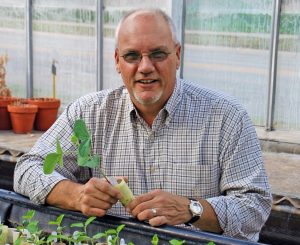Thoughts from the Ohio Field Leader on SCN Resistant Varieties.
By Dusty Sonnenberg, CCA, Ohio Field Leader, a project of the Ohio Soybean Council and soybean check-off.
Soybean Cyst Nematode (SCN) resistance is a good news, bad news situation. In a presentation given by Dr. Greg Tylka, Morrill Professor in the Department of Plant Pathology and Microbiology at Iowa State University, numbers were shared that commanded everyone’s attention. One number in particular, as the saying goes, virtually “sucked all the air out of the room”. That number was 22.4 bushels per acre. While 22.4 bushels per acre may not seem overwhelming at first, the combination of that yield difference along with the cash price of soybeans put the total over the top. This was further impactful considering the difference in yield was not between the plot control variety and the best resistant variety in the plot, but rather it was within the resistant varieties tested. There was a greater than 22.4 bushel per acre yield difference between the SCN resistant varieties in the trial.
When the math was done using the March 7th cash price and also the new crop price of soybeans, the air left the room. (March 2022 cash soybeans closed on the board at $16.74/bushel.) That is a difference of $374.97 per acre. Keep in mind, this difference is within SCN resistant varieties, and was in a field that did not have exceptionally high SCN populations. Even using the November 2022 new crop harvest price of $14.53 per bushel, the difference was $325.47 per acre. Increased commodity prices are increasing SCN losses.
Understandably, Ohio farmers are doing a lot of talking about the high fertilizer input prices (which are at record levels and continue to increase), of which they have no control, but seem to be missing a huge profit robber that literally may be right in front of their eyes. Knowing your farms SCN number in each field, and also knowing the SCN resistance variety being planted is increasingly important given the current research findings.

Every year Dr. Tykla conducts a series of on-farms trial evaluating soybean varieties resistant to SCN in Iowa. This year the yield difference of 22.4 bushels per acre was between an SCN resistant variety that had the Peking resistance gene and one that had the PI 88788 gene. In this study, conducted in Fruitland, Iowa, there were several different varieties of with SCN resistance. The yield average of the varieties containing the PI 88788 resistance was 51.2 bushels per acre. The yield average of the Peking resistance varieties was 72.4 bushels per acre. (It is worth pointing out that there were only 2 varieties in the study with Peking resistance.)
There are several important points of information gained. One take-away worthy to note is that not every variety with PI 88788 resistance provides the same level of SCN control in every environment. Another interesting factor in this study was that the average yield of the field where the trial was conducted was 50 bushels per acre and was planted to one of the SCN resistant varieties that was in the trial.
Dr. Tykla pointed out that the good news is all of this is that there are not additional technology charges to purchase seed with SCN resistance genetics, unlike other seed technologies that come with a tech fee. The bad news is that while the SCN resistant variety choices are abundant in the market, those containing a resistance gene other than PI 88788 are limited. “Almost all SCN resistance available to farmers is from PI 88788,” said Dykla. “In 2021 there were 872 soybean varieties that were SCN resistant. Of those, 836 had the PI 88788 gene. SCN populations have increased their ability to reproduce on and damage varieties with PI 88788 resistance, and this continues to increase. There are no indications that more soybean varieties with Peking or any other SCN resistance genes are on the way.”
This is a situation the industry needs to get in front of. “We have been stuck at less than 5% of the SCN resistance being from non PI 88788 genetics for 15 years,” said Dykla. Seed company breeding programs are long term investments and slow to be able to change due to the nature of the process. New varieties are developed from seed company breeding programs with advanced lines. The seed company pipeline is full of advanced varieties with 88788 that have added the herbicide resistance and other desired traits. “The cost in terms of time and money in developing a new soybean variety with something other than the PI 88788 resistance from scratch is much greater than developing new soybean varieties using stuff that is already in the pipeline,” said Dykla. The financial investment required to make a wholesale change is significant. With that being said, the growing resistance levels developing in SCN to single resistance genes in the soybean plant will be far exceeded by growers. It will not take long at $374.97 per acre to offset the seed company development costs. There needs to be a greater variety of the different resistance genetics available. If not, any single resistance will eventually follow the same pattern of SCN resistance development.